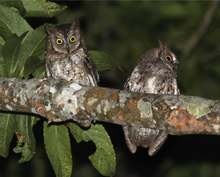Otus jolandae
| Rinjani scops owl | |
|---|---|
 |
|
| Two Rinjani scops owls perched on a branch | |
| Scientific classification | |
| Kingdom: | Animalia |
| Phylum: | Chordata |
| Class: | Aves |
| Order: | Strigiformes |
| Family: | Strigidae |
| Genus: | Otus |
| Species: | O. jolandae |
| Binomial name | |
|
Otus jolandae Sangster et al., 2013 |
|
The Rinjani scops owl (Otus jolandae) is a species of scops owl found only on Lombok in the Lesser Sunda Islands of Indonesia and its neighbouring Gili islands. The only bird species endemic to the island, it was first discovered in September 2003 and was formally described in 2013.
The specific epithet jolandae honours Dr Jolanda Luksenburg, a biologist who codiscovered the species in 2003. Both the English common name and proposed Indonesian name Celepuk Rinjani refer to Mount Rinjani, the 3700 m active volcano that dominates Lombok. The owls are also known locally as burung pok, referring onomatopoeically to the call.
As with most other Otus owls, the Rinjani scops owl is mainly brown in colour, barred and spotted in various shades with white. It is largely similar in appearance to the Moluccan scops owl, O. magicus, but has a different call, a clean whistling hoot rather than the raspy croak of O. magicus.
Seven specimens of the owl were obtained from May to July in 1896 by British naturalist Alfred Everett, who also used paid local collectors. However, at that time, the bird was not recognised as being specifically distinct from the Moluccan scops owl, which occurs on other islands in the Lesser Sundas. The Everett specimens are held in the British Natural History Museum (including the holotype) and the American Museum of Natural History.
In September 2003 George Sangster and Jolanda Luksenburg saw, and recorded vocalisations of, scops owls on Lombok. In the same month Ben King did so as well. Both parties independently concluded that the calls differed substantially from those of O. magicus and other Asian scops owls. In 2008 photographs and more sound recordings were obtained by Bram Demeulemeester and Philippe Verbelen. Another sound recording was obtained in August 2011 by Jan van der Laan.
...
Wikipedia
